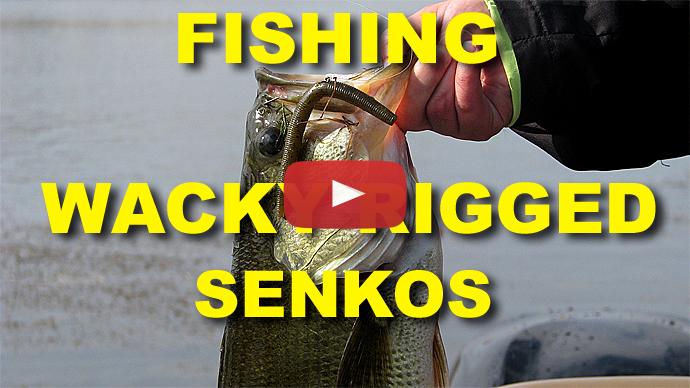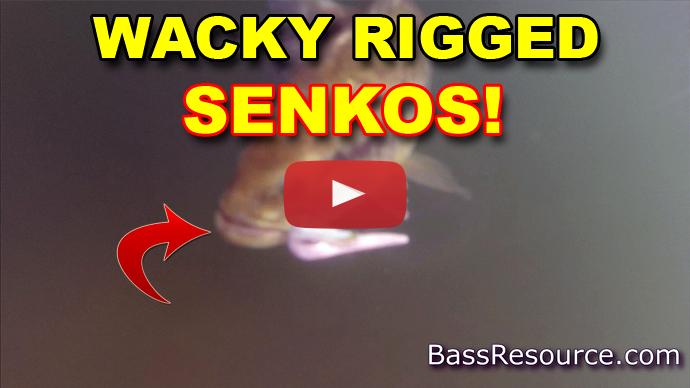John Crews here, what's up BassResource, giving you the tutorial of the spring wacky rig worm. That's right, spring is my favorite time of year to throw the wacky rig. I've got a couple different setups that I'm going to be using as far as the worm hook combination, and then I'm going to explain to you why I throw one versus the other and exactly when during the spring you're going to throw those. So we've got a lot to cover, we're going to get to it real quick here and we're going to start off with when do you start in the springtime.
When it's a pre-spawn period, I don't throw a wacky rig very much. Before those fish go on bed, I'm not throwing it a lot. That's not going to be in the top of my arsenal. The second that I know fish are on the bed, the second that they do, that's when I'm going to first go to the wacky rig.
The first bait that I'm going to go to is a weighted, thicker type of stick worm. This is Missile Baits 48, whether you like the Senko, 48, or you have some other brand that you normally throw, that is...when they are spawning, that's when I'm going to first go to this right here. I put a Gamakatsu Stinger, a weedless stinger, Gamakatsu G-finesse weedless stinger, number two, not the big number one or one-aught, the number two size. I've caught a zillion fish on that setup right there.
You can skip it very well, but what you're going to do is you're going to have it on a spinning rod setup. I usually have a seven-foot or seven three medium-heavy casting rod, and I'm going to have straight braid. This is the only time of year that I throw that straight braid. I don't think it makes a difference as far as getting bit if you have a leader or you have it on straight braid. I'll usually do 16-pound Sunline XPlasma on there, straight to it. I have the dark green color, goes all the way straight to the hook, and then I'm going to have a 3000 size reel, like a Daiwa, a Tatula or a similar reel. That's kind of the rod and reel setup.
I'm going to start out in the spring when they start spawning with that 48. What I'm going to do is I'm going to find those areas where they're spawning and I'm going to look for individual little pieces of cover. It might be one stump, it might be one stob, it might be a little cluster of pencil reeds, something in that spawning area that's a little isolated. Maybe it's just a couple, two or three lily pads together. Maybe it's just the closest dock piling in a spawning pocket where that dock is. Any area where you think that is where that fish has got to be spawning.
What I'm going to do is I'm going to take that 48, I'm going to pitch it or skip it into the area where I'm going to be fishing, where I think they're spawning, and I'm going to let it sink to the bottom. Then I'm going to give it little short jerks and then let it sit. This is the...when they're spawning, that's the slowest cadence, the slowest way that you work it is when they're spawning. That is when that 48 really, really shines. That's really what you want to do throughout the early half of the spawn.
Towards the latter part of the spawn, what's going to be happening is that the bass, a lot of the females are going to be, I call it serviced. They're going to be serviced already. They're going to come in and lay their eggs. You're going to have those buck bass that are going to be there, and you're going to have some newer females moving in. So there's going to be females moving in, females moving out.
During that time of year, I change up my setup. During that time of year, I'm going to go to a much slower falling bait because the water temperatures later in the spawn and into the early post spawn. That's when those water temperatures are really going to start to rise. What happens when you get some sun, like we have here, when you get some sun, it's going to warm that water. What happens when you get some sun, it's going to warm that water. What happens as those bass, as those eggs hatch from the spawn their fry are going to come and when it gets sunny, those fry come up towards the surface.
I want to have a bait that's high in the water column. I don't want to have a bait that's low in the water column, like a weighted stick worm, Senko type situation. I want something that's going to sink very slow. I use the Missile Baits Magic Worm made by Roboworm. I use that because it sinks very, very slow. I have no weight on there. I have a number one octopus hook from Gamakatsu on there.
Same setup, but when I throw that out there, that worm sinks really, really slow. I'm going to pitch it to those same areas that I was talking about concentrating on. That little isolated piece of cover in those spawning pockets, I'm going to throw to that, but instead of letting it sink to the bottom, I'm just going to slowly twitch it. This worm is going to collapse, go straight, collapse, go straight. It's just going to barely sink. It'll be within a foot of the surface. That bait is going to be way up in the water column.
A lot of times, you'll be watching your line, and all of a sudden, you'll see your line just start taking off. That fish will come up and get it and go back down and take off. Really, what's going on is that those fry that I was talking about, those isolated pieces of cover, instead of the bass spawning next to that stump or that stick, the fry are going to be using that for cover. They're going to be using that shallow dock piling or that little bush or whatever it is that's isolated. That's what they're going to be around when that sun comes out. When you throw that wacky rig by there and twitch it, it looks like something that's trying to eat those fry. That male bass is going to come over there most of the time and eat it.
We're not talking small male bass. A lot of times, these male bass are going to be three and four-plus pounders. We're not talking about just whacking a whole bunch of dinks. We're talking about you could have potential to catch some really big bass.
Before we go too much further, I want to talk about colors in with these wacky worms. During the spawn, Green Pumpkin is always a good color, period. Green Pumpkin, Green Pumpkin money, always a really good color. Sometimes colors with a little bit of red in there, like a Watermelon Red, can be very good during that spawn time. That first pre-spawn type spawn period I was telling you about with the weighted worm, a watermelon red type of worm can be fantastic. If you've got some tannic water, Florida kind of stuff, Bruiser Flash, which is a black and blue, really, really hard to beat. But as you get later into that spawn period, I've got a couple options. If I've got a little bit cloudy conditions, we have some intermittent cloud sun here, I might be going to a contrast color like Ed's Orange. I love orange on a wacky rig when it's not real bright. That, for some reason, is just a magnet. They love it. They'll come to it. They'll defend their fry for it. But when it gets water a little clearer, and you've got sunny conditions, things get kind of tough. Then there's a color called Watermelon Violet that, for some reason, I have caught a lot of fish on. When it slicks off and gets sunny, a lot of people start complaining about not being able to get bit. That color, for some reason, it's a translucent, it's got that little violet in it, it's got a little blue in it. For some reason, that type of a color really, really excels during that later spawn, post spawn period with the wacky worm.
I can tell you it's one of my favorite ways to catch fish. I love it because even in elite series events, I can go right behind other pro anglers that are not throwing a wacky worm, and I can just catch fish after fish after fish.
So whether you're in a tournament or you're just going out fun fishing, you get in those spawning areas, sometimes it's discouraging when you see other anglers in those areas, and you think, man, I don't want to have to go behind that guy because I'm sure he caught all the fish. Dude, I'm telling you, wacky worms, you can go right behind other anglers. And if they're not throwing like that really slow sink in the post-spawn period, they ain't going to be doing any damage.
So keep those tips in mind. If you have any other questions or comments, be sure, as always to drop it down there. And if you're not already subscribed to BassResource, you know you have to go down there and do that thing, too. So I appreciate everybody watching.



